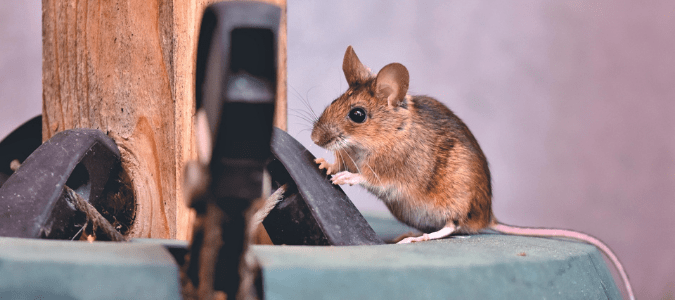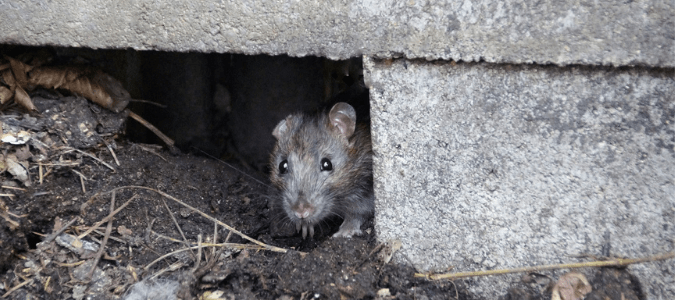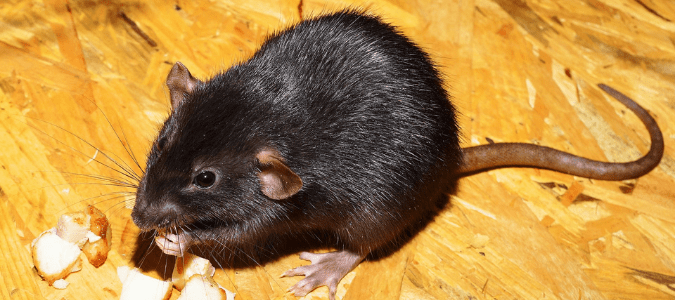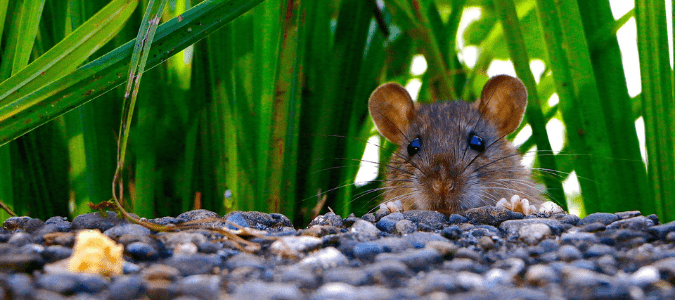When you suspect you have a rodent problem, the first step is to identify what type has invaded your home. This is because different forms of rodents require different control strategies. Unfortunately, most homeowners aren’t experienced in wildlife identification and control. So, it’s often difficult for them to figure out on their own what kind of creature they’re dealing with. Nonetheless, there are some initial steps you can take to try to identify what kind of pest is in your home or yard.
Although there are many different rodent species out there, ranging from mice to porcupines, not every type of rodent will seek out your property. The most common types of rodents that can live in residential areas are house mice, Norway rats and roof rats. With these rodents, each type has some distinctive characteristics that stick out.
House Mice
As you can see in the image above, house mice are small creatures with large ears and small, black eyes. They weigh between a half-ounce to an ounce and are light brownish to dusky gray in color. Adult mice are about 5 to 7 inches long, including their 3 to 4-inch long tail. House mouse droppings are only about a quarter of an inch to a half-inch long. You can also tell if you have mice or rats based on the number of droppings you’re finding. Mice produce around 70 droppings a day, whereas rats produce around 50 droppings a day. If you’re finding a bigger volume of what looks like dark oblong-shaped pellets, it could indicate you have a mouse problem.
House mouse nests consist of finely shredded paper or other fibrous material. You’re most likely to find a mouse nest in a sheltered location. A musty smell can also indicate that house mice have become established on your property.
Norway Rats
Norway rats are sometimes called brown rats or sewer rats. These rats are more stocky and larger than roof rats and can weigh over a pound. They’re long too, measuring between a foot to a foot and half in length when you include their tail. Norway rats are gray with a white underside and can leave greasy track marks where they travel. These marks are their natural oils rubbing off. Norway rats produce large droppings that are between a half-inch to three-quarters of an inch long and the droppings have more blunt ends.
Probably one of the most distinctive features of Norway rats is their nesting habits. Norway rats burrow into the ground to create nests. When these rodents invade homes, you can typically find them on the ground floor or in crawl spaces. Homeowners may find burrows along foundations, beneath woodpiles and in moist areas. Sometimes, these rats line their nests with shredded paper, cloth or other materials.
Roof Rats
Roof rats, also sometimes called black rats, are quite a bit smaller than Norway rats. These rats weigh in at less than half a pound and are grayish-black with a pale yellow belly. Unlike the Norway rat, the roof rat’s tail is longer than the length of its body. Roof rats measure between 12 inches and 18 inches in length, and they may also leave greasy track marks where they travel. Roof rat droppings are usually about a third of an inch to a half of an inch in length, and have pointed ends.
As their name implies, roof rats are often found in enclosed or elevated surfaces. This is due to their excellent climbing abilities. Outside, roof rats may nest in shrubs, trees or dense vegetation, like ivy. Inside, roof rat nests can be found in attics, walls, false ceilings and cabinets.
If you suspect you might have a rodent infestation in your home, it’s wise to contact a pest control specialist. They can help protect you, your family and your pets from the risks that rodents pose. Rodents often carry diseases that they can pass onto humans and pets. They can also cause significant property damage as they chew on materials to shorten their ever-growing teeth. This habit can even lead to house fires if they chew on electrical wiring.
Rodent control professionals can take care of all the details of your pest problem, so you don’t have to deal with it. They can also identify the rodents that are living on your property. Better yet, they can clear out these pests using proven methods and help prevent future infestations.
Although many people love having a garden, it can attract rodents and other wildlife. Keep reading to learn how to keep rodents away from your garden and what to do if rodents are avoiding your traps.
How to Keep Rodents Out of Garden
There are a variety of traps and repellent products available for purchase online and in local hardware stores designed for rats and mice. But often, the best way to keep rodents out of your garden is to make the area less attractive to them. You can do this by removing potential food and nesting sources. If you want to take steps on your own to try to deter rodents from your garden before contacting a professional, there are some things you can try.
Protect Your Trash
Keep your outside garbage in a container that’s made of a durable material like metal. Make sure your bin has a tight-fitting, rodent-resistant lid. To prevent rodents from getting inside, you can secure the lid with chains, a bungee cord or heavy rocks. Additionally, avoid leaving any kind of smelly garbage like raw chicken in your trash can for long periods of time. If your trash day isn’t soon, consider keeping food scraps and other rodent-attractive items in your freezer. Wait to put these items out until shortly before your garbage service comes.
Clear Out Any Potential Food
Avoid storing any type of food, such as birdseed or pet food, outdoors. If you keep birdseed or pet food in areas rodents can get to, such as a shed or garage, keep it in tightly sealed containers. Additionally, if fruit or nuts fall from your trees, pick them up off the ground as soon as possible. Promptly clean up any seeds that fall from your bird feeders. You can also try using a feeder that recaptures seeds that fall.
Another thing you can do is to pick up your own food scraps and crumbs if you eat outside, and clean up after your pet. If you feed your pet outside, only give them the amount of food that they can typically eat in one sitting. Then, promptly clear any food they don’t finish.
Mind Your Compost Bin
Use a secure and rodent-resistant bin in any outdoor compost bins, plus avoid putting food like meat, animal fat or grain inside. To provide less of a draw for rats and mice, only compost refuse from your garden, such as leaves, weeds and grass.
Clear Excess Vegetation
Rodents can use vegetation for nesting materials, so it’s helpful to remove any clutter in your yard. Look out for ivy, tall weeds, tree branches, shrubs, log piles or other organic matter in your garden.
Keeping rodents out of your garden is helpful for many reasons. For one, you can have peace of mind that you’ll be able to enjoy the fruits of your labors, such as fresh vegetables, instead of any resident rodents. Also, rodents can make their way into homes after finding a plentiful food source in a garden. So, taking these preventative measures can help protect your home from a rodent infestation.
Nonetheless, rodents can sometimes find their way into even the neatest of gardens and cleanest of homes. If this happens to you, it’s wise to contact a rodent control specialist when you spot a rodent or signs of possible infestation. These professionals will meet with you to develop a pest control plan that best fits your needs. Plus, they can do the hard work to get rid of rodents in and around your home and help prevent future pest problems.
Although hiring a rodent control specialist is the easiest way to deal with a pest problem, some homeowners want to see if they can deal with it themselves. Often, when this happens, homeowners find themselves wondering if rats learn to avoid traps.
Do Rats Learn to Avoid Traps?
It’s frustrating if you set traps but haven’t been able to catch the rodents living around your home. However, there are some basic reasons why rats might have learned to avoid your traps. For one, many rodents are intelligent and instinctively avoid things that might harm them.
When a new object like a trap appears in their environment, they will likely avoid it until they know it’s safe. Because of this behavior called neophobia, rats might even avoid the area of the trap altogether and find a new path to get from their nest to their food. This is why traps are sometimes ineffective as a rodent control strategy. What’s probably more accurate is that most homeowners may not understand rodent behavior well enough to know where, when and how to correctly use traps.
It’s often important to use tactics to overcome the rat’s neophobia before they’ll even approach the traps. One way to do this is to introduce the trap as a “friendly” object. That’s to say, you can try placing a baited trap in the rat’s environment without setting it. Eventually, the rats will likely learn to think of the trap as a safe object after they approach it and take the food. Once the rats have adjusted to the trap, you can then add more bait and set the trap. The trap will be more likely to attract and capture the rodents.
It’s also important to use the right kind of bait for your traps. Try using foods that contain protein, such as peanut butter or a slice of hot dog. And, make sure you’re placing the traps in the right places. Rats have typical routes that they use to travel between their food and nest. These routes are typically along walls and floorboards. So, a trap in the middle of the floor will likely never catch a rat.
It can take a while for homeowners to learn the best places to place traps and the best kinds of bait to use. In the meantime, these pests might multiply and become an even greater problem. That’s why it’s smart to contact a rodent control specialist at the first sign of rats. These pros can do the dirty work to quickly capture and remove rodents from your home, so you don’t have to deal with this type of problem or all the headaches that come with having rodents in and around your home.
ABC Can Trap and Remove Any Type of Rodent
Even figuring out what rodent is on your property can be difficult. In the time spent identifying what pest you’re dealing with, rodent populations can grow. If you’re dealing with any type of nuisance rodent or wildlife, contact ABC Home & Commercial Services. Our professionals have the expertise and tools to identify and remove unwanted pests. We also offer ongoing pest management so you don’t have to worry about a future problem.




